Chinese New Year Festival in Yaowarat, Bangkok
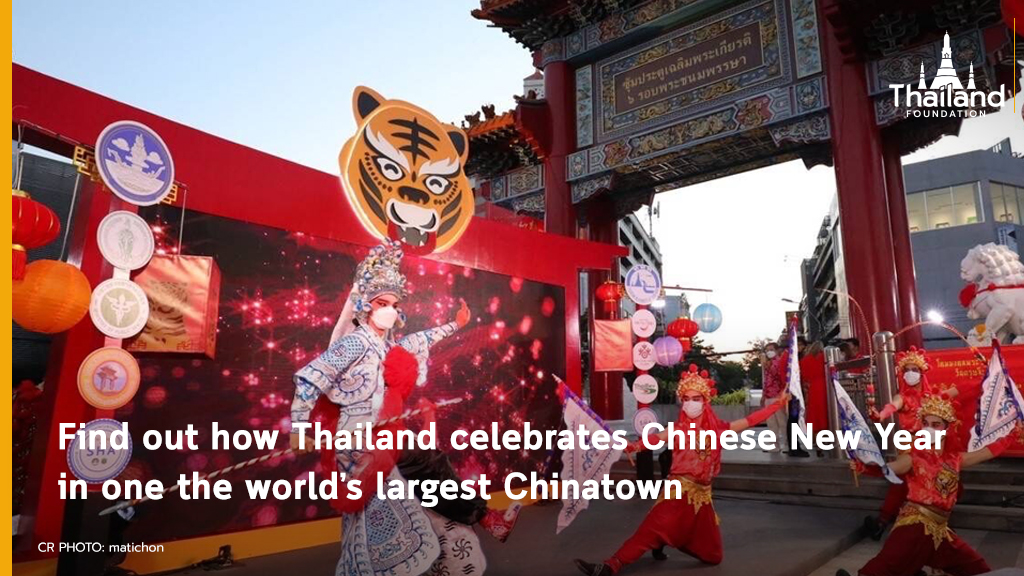
China is the country with the largest population in the world. It is no wonder that their language, food, traditions and celebrations are appreciated around the globe, including Thailand, one of the countries with the strongest overseas Chinese presence. Therefore, it is simply natural to see the elements of Chinese culture fusing with the way of life of Thai people and elements of Thainess merging into the identity of Thais of Chinese descent. As the Chinese New Year is approaching, this is a great opportunity to learn about the story of the Thai-Chinese people and the grand celebration in the Chinese community of Thailand.
When did Chinese people settled down in Thailand?
Most Chinese in Thailand are those who speak Cantonese, Hakka, Teochew, Hokkien, and Hainanese. This is evident through the numerous Chinese shrines; associations for Chinese families, languages and dialects, hometowns, and occupations; and Chinese schools that are run by these five groups of Chinese people.
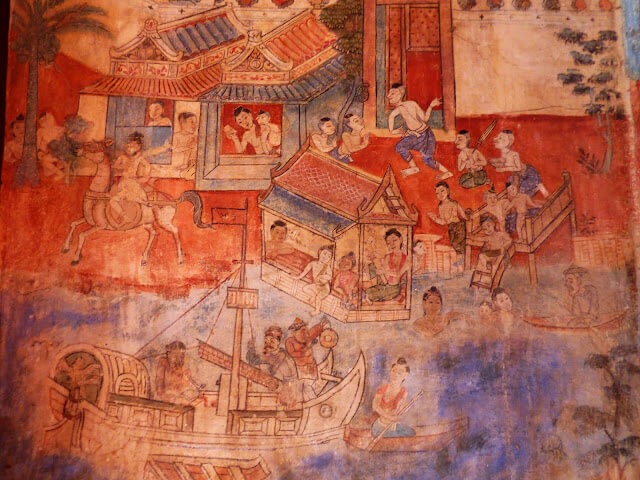
Chinese merchants depicted on the ancient murals of Wat Thung Sri Meuang, Ubon Ratchathani Province
During the Tang Dynasty (618-960), the prosperity of China’s maritime trade sent Chinese merchants on lucrative missions in various regions, including Thailand. We may divide the timeline of the Chinese immigration to Thailand in five waves as follows:
- Wave 1 the Pre-Ayutthaya Period or Tang Dynasty (618-907) – Chinese sailors and merchants began to settle down in port cities in southern Thailand.
- Wave 2 the Ayutthaya period (1424-1767) – Successful Chinese merchants and businessmen traveled to Thailand. The Thais refer to this group of Chinese travelers as “the Old Chinese.”
- Wave 3 the reign of King Taksin (1767-1782) until the reign of King Rama IV (1850-1868) – Chinese immigrants during this period were mostly from the Teochew city since King Taksin was of Teochew descent.
- Wave 4 the reign of King Rama V (1868-1911) – This wave of Chinese crossed the border before a tight immigration policy was imposed in Thailand.
- Wave 5 the reign of King Rama VI to 1950 – This wave saw the smallest number of Chinese due to global and local political disruption.
Integration of Thais and Chinese
One thing that is very obvious in the relationship between the Thai and the Chinese is that Thai people have been open and willing to embrace the Chinese culture since the beginning.
In terms of commodities, trading with the Ming dynasty (1368-1644) introduced Thais to new-fangled products from China, such as porcelain wares, exotic fabrics, carved ivory, metal ornaments, Chinese ink, tea leaves, and Chinese medicinal utensils. These items were popular with both the royal family and commoners.
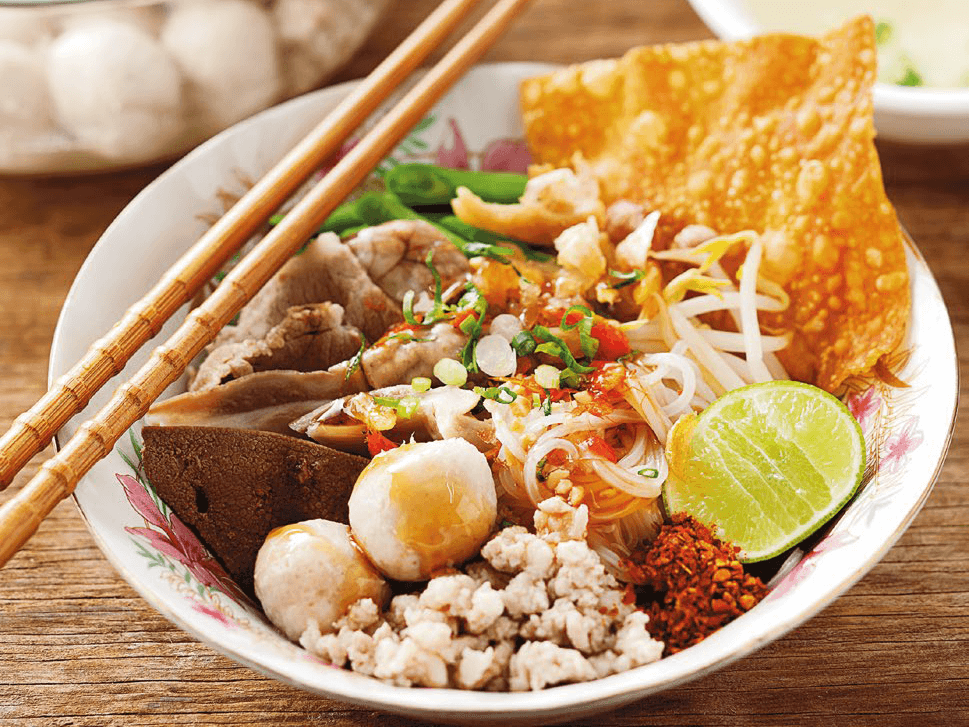
Guay tiew – Thai noodles- originated from Chinese noodles [cr. goodlifeupdate.com]
On gastronomy, the integration was clearly visible, particularly on the noodle menu. Thais learned to enjoy a large variety of noodles – rice noodles, egg noodles, and so on – which have, in a blink of an eye, become typical dished in Thailand. Boiled rice, steamed buns, and stir-fried noodles with soy sauce or Pad See-Ew are equally popular.
On social mobilization, as more Chinese entered Thailand, King Rama VI announced a policy to build harmony between Thais and Chinese. As a result, Chinese immigrants began to adopt Thai surnames, with a Chinese touch. For example, the family name “Bae” (马) which means “a horse” has become “Silpa-archa” (ศิลปอาชา) in Thai meaning “an artful horse.” Others may choose to combine Thai-style and Chinese-style names. For example, the family name “Jia” (谢) has become became “Jiarawanon” (เจียรวนนท์). Some Chinese also chose to keep their family name as it is by adding a Thai word “Sae” (แซ่), which means “a family name” as a prefix, such as “Sae Tang”, “Sae Jong”, “Sae Lim,” etc. In addition, Thai royal titles were also awarded to quite a number of Chinese, especially “the Old Chinese,” who are highly regarded by the Thai people.
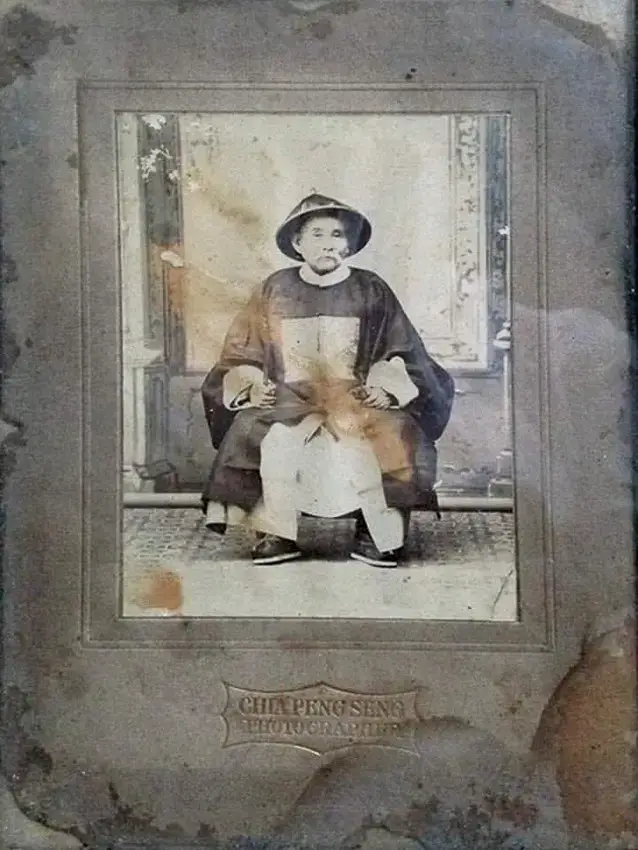
Chao Phraya Nikornbodin (Ng To) a Hokkien Chinese who became a Chief Minister during the reign of King Rama III
[cr. The Cloud]
Culturally, many Thai people today are of Chinese descent and practice both Thai and Chinese traditions seamlessly. Thai Chinese communities have never forgotten their cultures and roots. They have built Chinese temples, shrines, or almshouses wherever there is a Chinese community, and carried out Chinese religious ceremonies and traditions every year up until these days. The Chinese associations for language groups, families, and hometowns are present everywhere in Thailand where Chinese people are, not only in Bangkok. The worshipping of gods and ancestors, the Mid-Autumn Festival or the Moon Festival, or the Chinese vegetarian week are all received and practiced by the Thais. Some traditions, like the vegetarian week, are also compatible with the religious beliefs held by many Thais who prefer to abstain from meat consumption to cleanse their bodies and minds.
Yaowarat Chinatown
The Yaowarat neighbor in Bangkok is one of the areas where a large Chinese population settled in Thailand. Here, we can find all things Chinese, from food and snacks to apparel, herbal medicine to incense sticks and candles for Chinese ceremonies. In the beginning, most Chinese people started off their businesses by bringing goods from their country to sell in Thailand and bringing products from Thailand to sell in China. Some of them acted as intermediaries in business dealings. Other Chinese would trade their labor with money or cook and sell Chinese food as hawkers. Being financially prudent in nature, the Chinese when collecting enough money would open permanent restaurants and shops. And step by step, their perseverance and business vision have made Yaowarat what it is today.
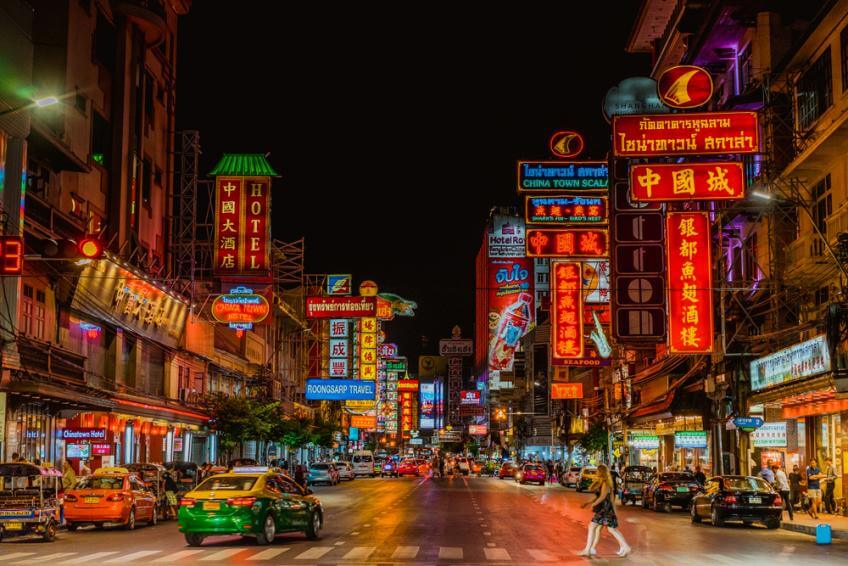
The iconic Yaowarat Road [cr. True ID]
Yaowarat is one of the world’s largest Chinatowns. Once you set foot in the zone, you will feel as if being transported to another world. Commercial buildings are punctuated with the Teochew architecture in which the roof arch is decorated with dragon statues, the interior featuring exquisite Chinese paintings and flower motifs. The hustle and bustle of activities, the sounds of people laughing, the voices of food vendors asking for customers’ attention, the smell of food, and the red and yellow colors of restaurants, especially the neon lights at night, all make the Chinatown of Yaowarat uniquely charming.
A large Chinese community has been present in the area of Bangkok for a long time. When the City was made the new capital of Siam in 1782, the community was relocated from the area of present-day Rattanakosin Island to what would eventually become the Yaowarat neighborhood. During the reign of King Rama V (1868-1910), the King ordered the construction of the Yaowarat Road which was the first road in Thailand planked with buildings of seven to nine stories, the tallest in the kingdom at the time. The road ran through the Chinese neighborhood and was an absolutely popular hangout area of that era. In 1871, the King gave a royal permission to build a Mahayana temple named “Leng Nei Yi Temple” and bestowed a royal name of “Wat Mangkon Kamalawat” as a place of worship for the Chinese and Thai alike who come to seek a spiritual refuge. Eventually, the area would come to be known as the “Yaowarat Chinatown”.
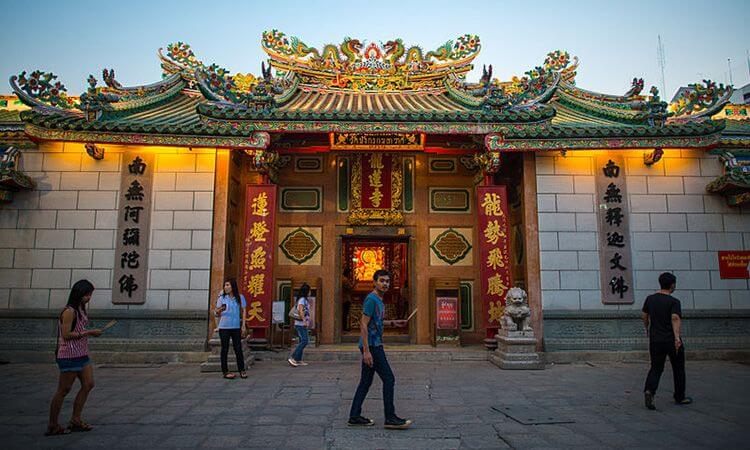
Wat Mangkon Kamalawat [cr. Thai Ticket Major]
Regarding social values, Yaowarat is home to many charities including the Thian Fah Foundation which is the first charity foundation of Thailand established in 1902 with the support of merchants and businessmen. Most recently, in 2009, the Traimit Temple Museum was opened to the public as a Yaowarat Historical Center. The temple chronicles the story of Chinese people in Thailand.
Yaowarat Chinese New Year Festival
The liveliest period of Yaowarat is the Chinese New Year. No matter where you look, you will see bright red lanterns adorning the shops or along the streets, signaling the joyous festivities. Red lanterns represent prosperity and wealth, and help ward off the evil. Moreover, red is considered an auspicious color in China, symbolizing good fortune, luck and prestige.
Thais of Chinese descent look forward to and take this day very seriously. Houses are cleaned. Shops and department stores are full of people spending on new clothes for their children, and gifts for relatives and friends. The markets are filled with people buying fresh produce for the celebration, everything looking bright and happy. Paper offerings are also popular items being sold during the season. These offerings are burned as gifts to ancestors and deities.
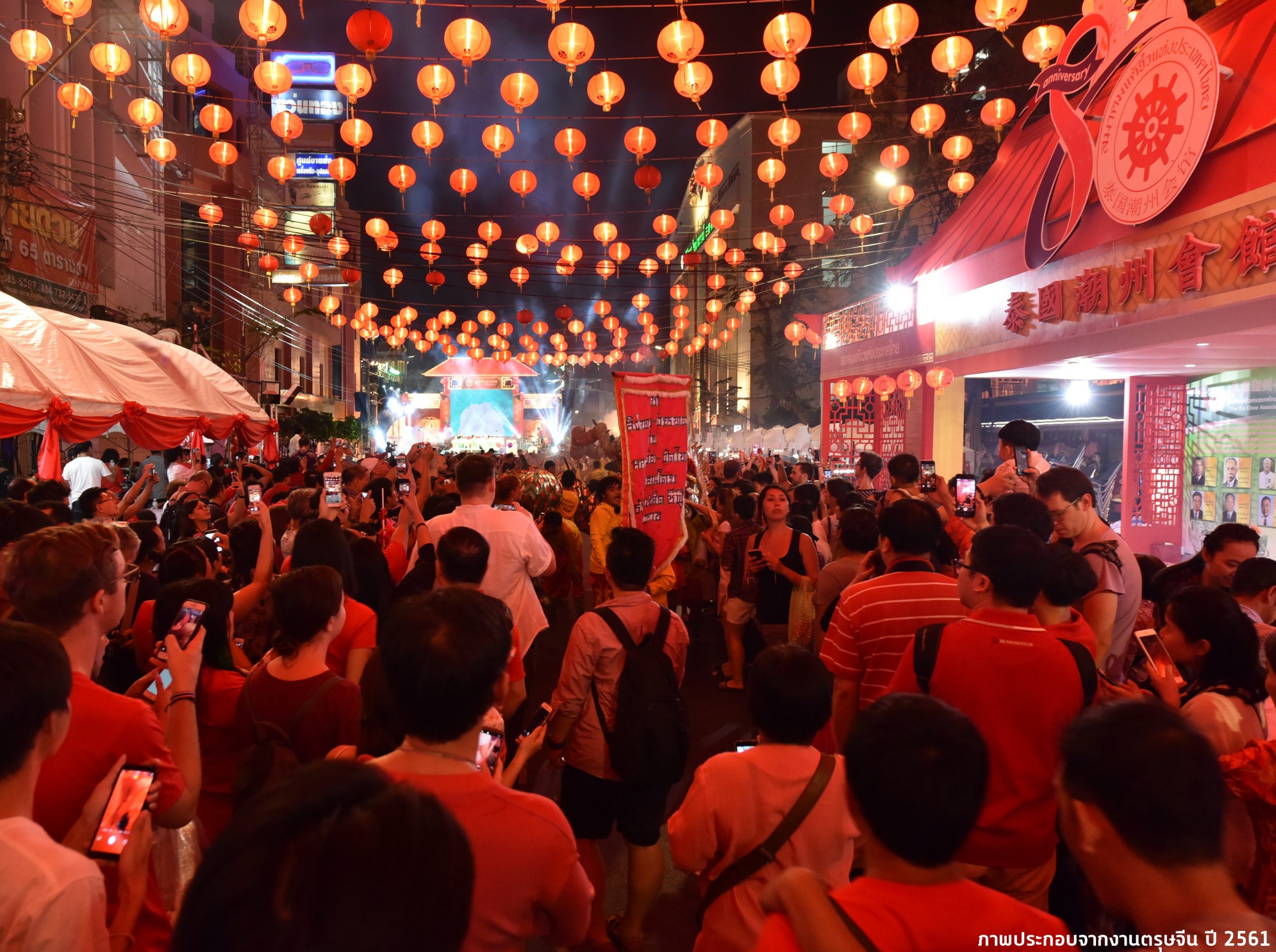
2018 Chinese New Year Festival [cr. Pracharath Rak Samakkee]
Temples and shrines are filled with worshipers, seeking divine blessings for the upcoming year. There is a prevalent belief among Thai-Chinese that, if a person’s traditional zodiac sign is “incompatible” to the zodiac of the year, he/she will face bad luck. The person born in the Year of the Rat, for example, is said to face increased hardships during the Year of the Horse. In such cases, the unlucky individuals will perform ceremonies to ward off evil and pray to deities to protect them throughout the year. Many temples and shrines in Yaowarat are popular spots for such rituals. These include Wat Thippaya Waree Wihan (Kam Low Yi in Chinese), where a sacred well is located, and the aforementioned Wat Mangkon Kamalawat, among others.
The activities that Chinese and Thai-Chinese people in Yaowarat jointly organize include cultural performances from China, distribution of souvenirs to tourists, Chinese New Year markets where auspicious items and food are sold, a grand and majestic dragon parade and a lion dance, and special concerts by popular singers. An important center of the festivities is located at the Dragon Gate (a.k.a. the Gate of Commemoration of the 6th Cycle Anniversary of HM the King’s Birthday) near Trai Mit Temple. The gate was built through a cooperative effort between the Thai-Chinese community, businesses, and the government sector in order to commemorate the 72nd Birthday Anniversary of HM King Bhumibol Adulyadej the Great.
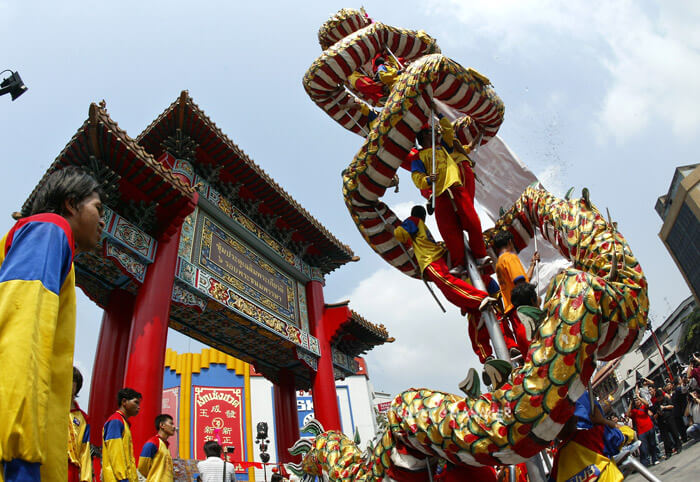
Dragon dance at the Dragon Gate [cr. Manager Online]
In addition, Princess Maha Chakri Sirindhorn presides over the opening ceremony of the Chinese New Year celebration at Yaowarat every year as part of her royal duty. This emphasizes the strong bond between Thais and Chinese at all levels, from the commoners to the royal family.
******************
It is not exaggerating to say that the Chinese people and their culture have seamlessly been integrated into the Thai society. It is a living proof of the age-old friendship and cooperation between the Thai and Chinese people. As a saying goes: “จีนไทยใช่อื่นไกล พี่น้องกัน” “Thai and Chinese are not strangers but brothers and sisters.”
Sources:
https://www.silpa-mag.com/songwad-century/article_26173
https://www.prachachat.net/d-life/news-286207
https://www.posttoday.com/social/royal/579364
https://promotions.co.th/travel/chinese-new-year-2020-activities-what-highlights-are-yaowarat.html
https://travel.trueid.net/detail/pPAvlg8OM0Go
https://urbancreature.co/yaowarat-nescafe-mrt-watmangkon/
https://db.sac.or.th/museum/article/18
https://db.sac.or.th/museum/museum-detail/195
Author: Soonyata Mianlamai
1 Feb 2022


